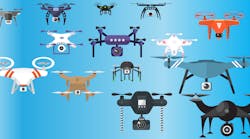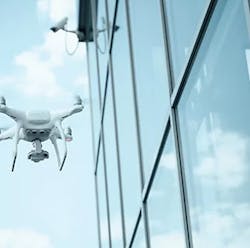Unmanned aerial systems (UASs) have long been associated with the battlefield, but they can increasingly be found in commercial and civilian applications, creating growing needs for counter-UAS (C-UAS) solutions. A C-UAS is designed to detect, identify, track, and sometimes mitigate or destroy enemy military UASs and irresponsible commercial drones. The growing market for C-UAS drones is being fueled by increasing use of UASs on the battlefield and the rapid growth of inexpensive, consumer-grade drones.
According to an analysis by market specialists Frost & Sullivan, “Global Counter UAS Market, Forecast to 2024,” requirements for sophisticated UAS equipment for military applications are driving demand for practical C-UAS solutions. But commercial and civilian users are also seeking low-cost C-UAS solutions that can locate threat drone operators, ideally by using open-architecture software that enables integration into existing security systems. Based on current market growth trends, Frost & Sullivan is predicting revenues from C-UAS markets to exceed $2 billion by 2024.
Market research shows that demand is rapidly growing for counter unmanned aerial systems (C-UASs). (Courtesy: D-Fend Solutions)
“The rapid proliferation of small drones and their expanding threat is driving significant investment and innovation in C-UAS. However, adoption of these technologies is limited by individual country rules against wiretapping, jamming, and computer hacking—all methods employed by various C-UASs,” said Michael Blades, vice president of aerospace, defense, and security for Frost & Sullivan. “To gain a competitive advantage in an evolving ecosystem, players should look toward developing robust analytics and enabling/optimizing passive detection sensors, which can accurately capture and record data during all phases of the kill chain,” he added. Regionally, North America, led by the Department of Defense (DoD), is expected to spend the most on C-UAS equipment during the market growth period.
Technologies in support of C-UAS market growth include artificial intelligence (AI) and directed-energy weapons, such as lasers. AI algorithms are needed to automate the detection, identification, and tracking of threat drones with minimal false alarms. High-efficiency, lightweight directed-energy weapons are needed to eliminate multiple threat drones quickly and/or simultaneously. As Blades observed: “OEMs that show their systems can be effective against the majority of current threats and can be adapted to future threats will realize the most market advancement.”


